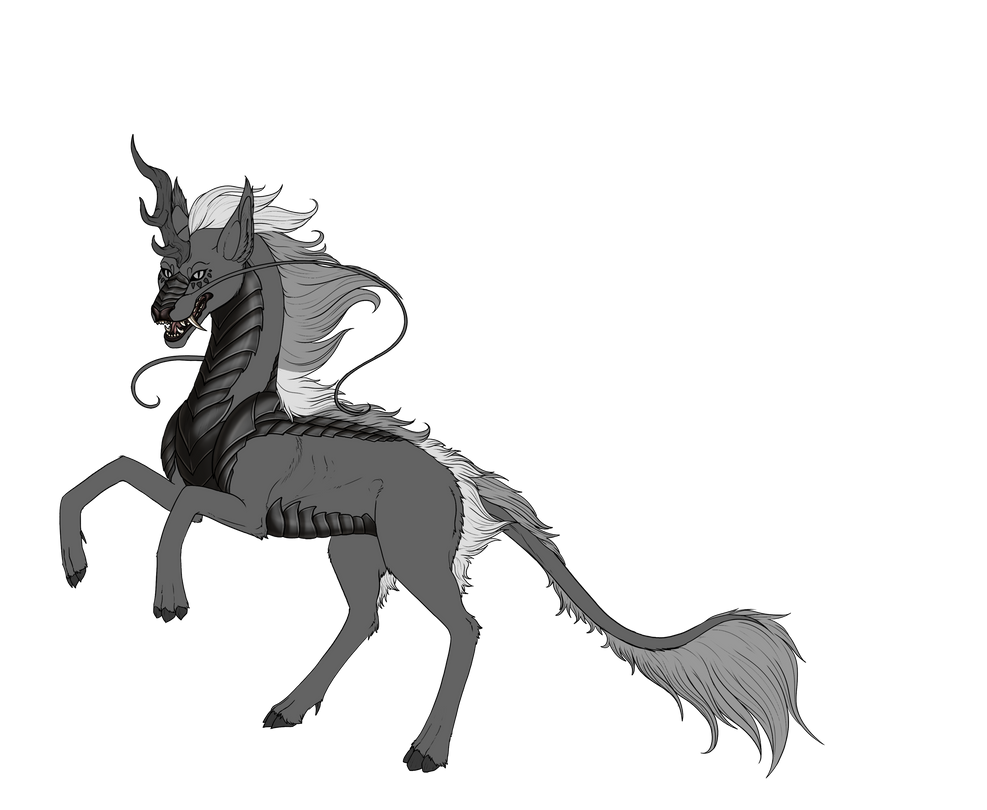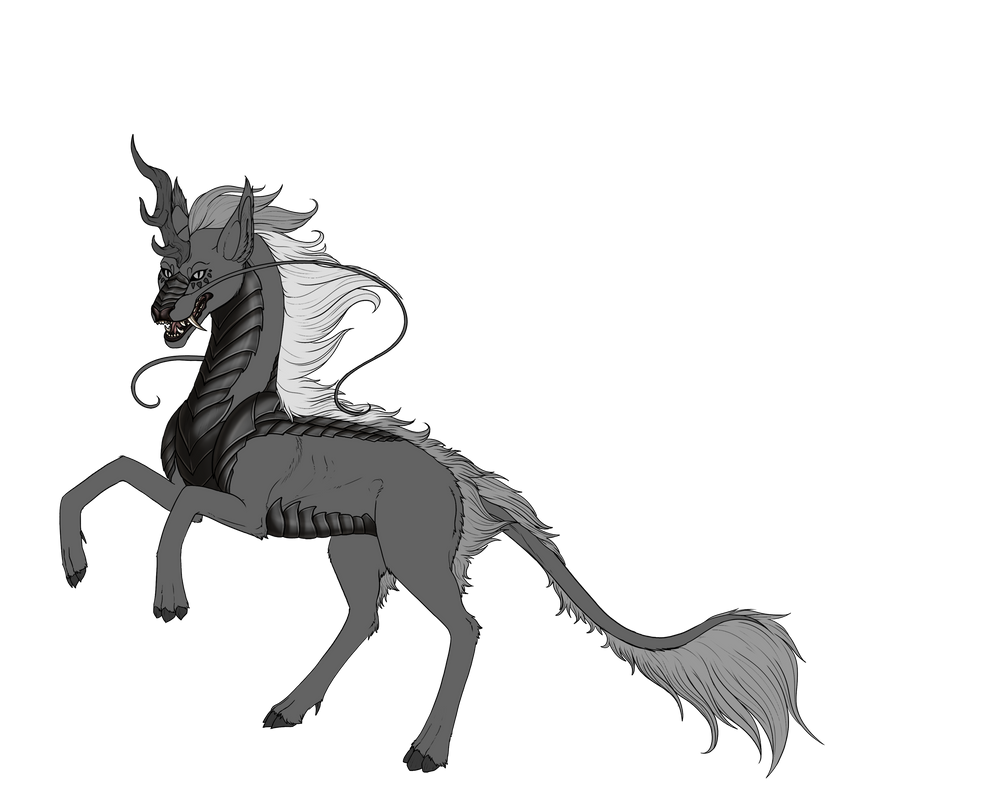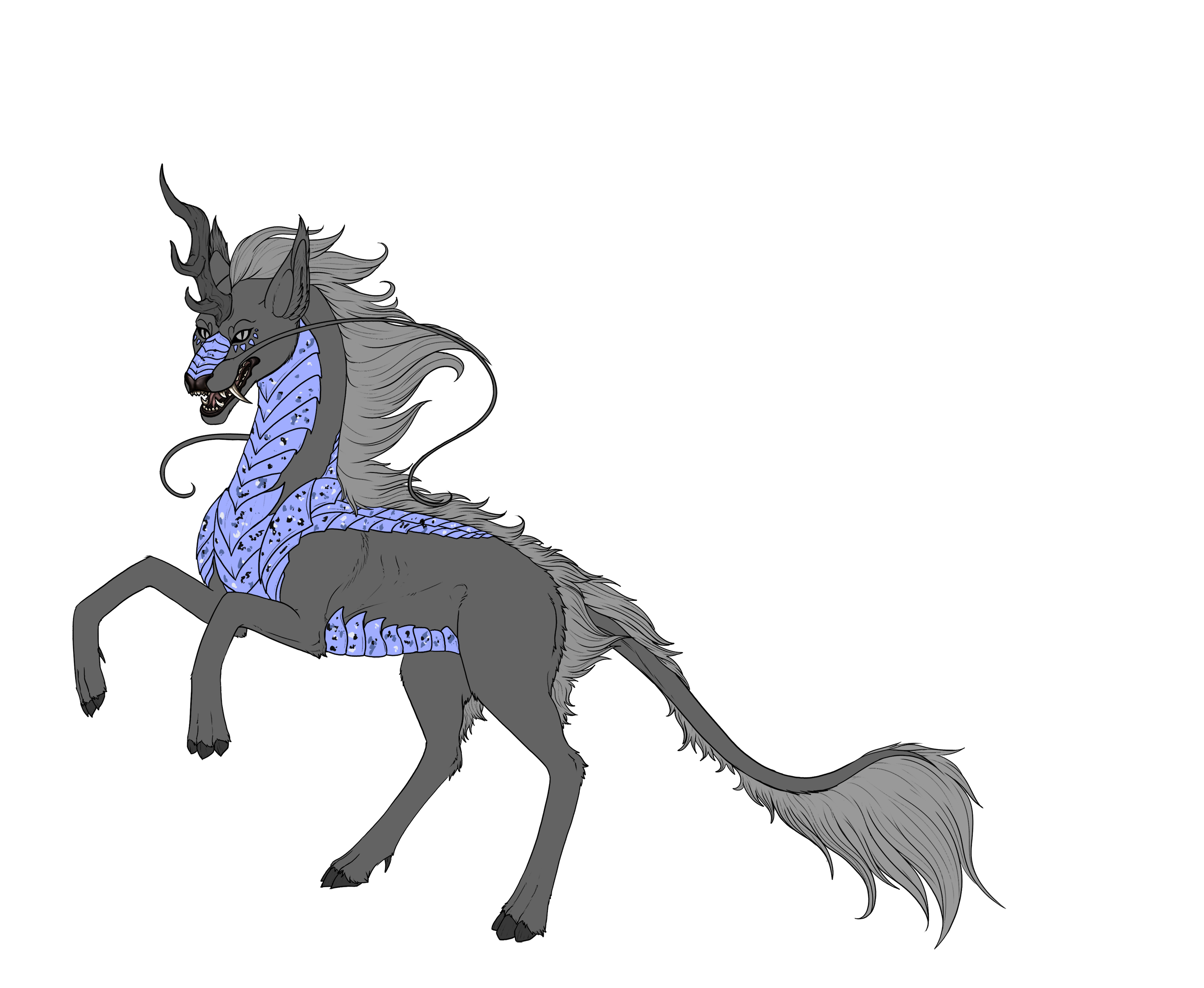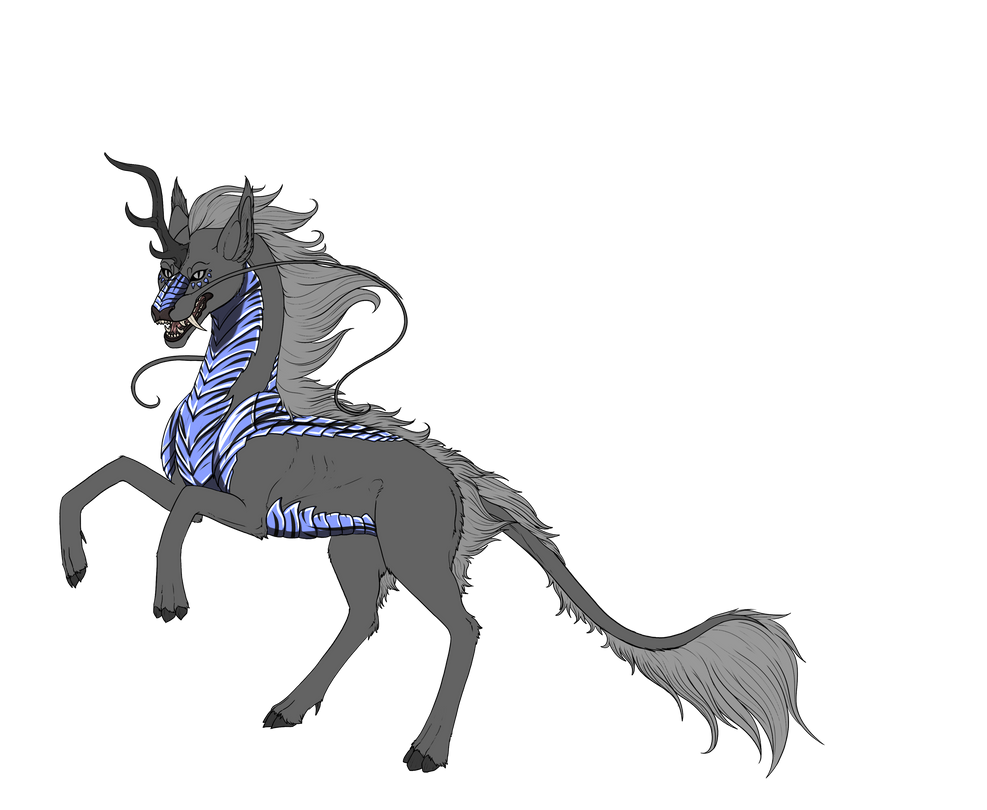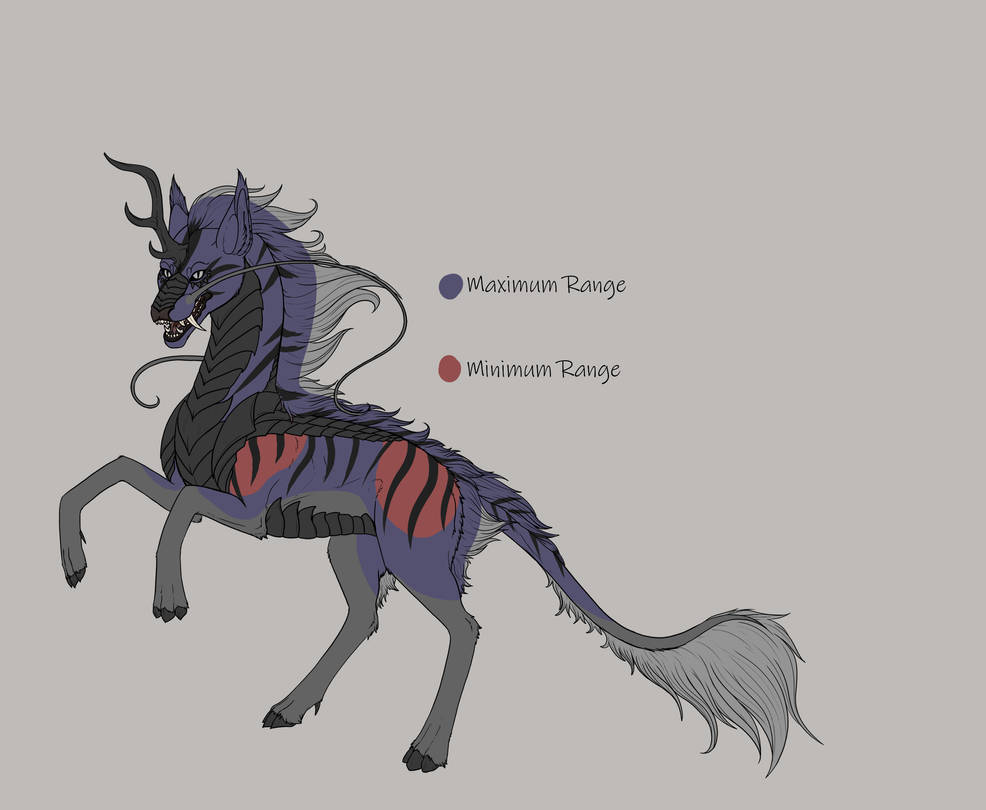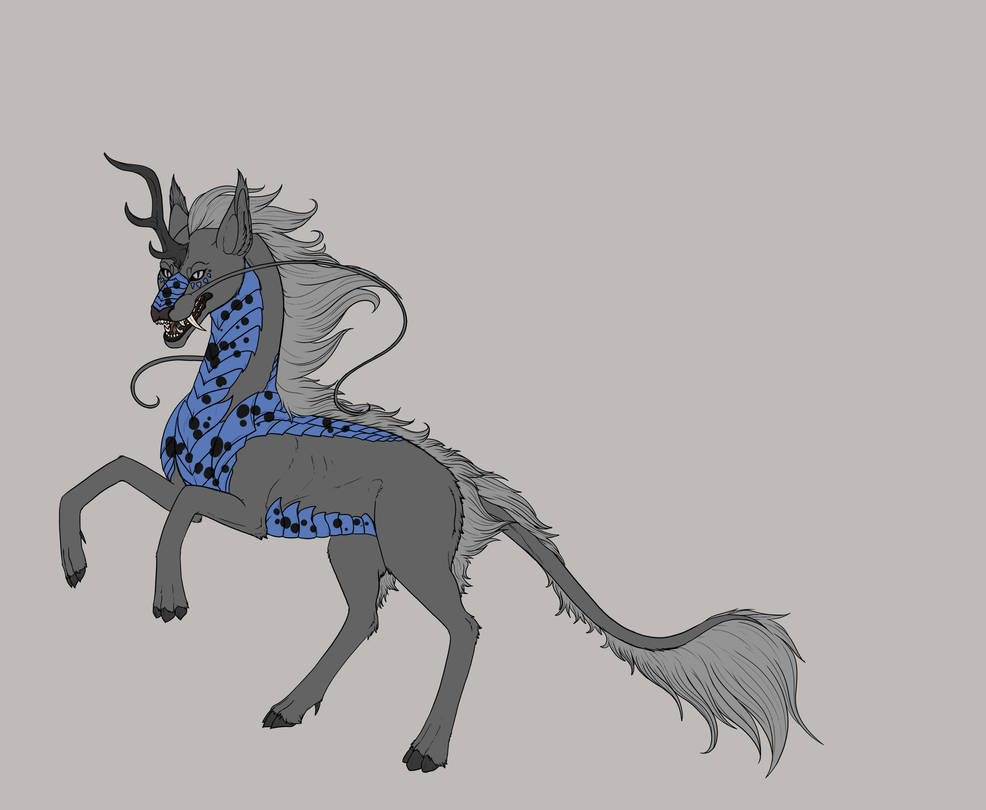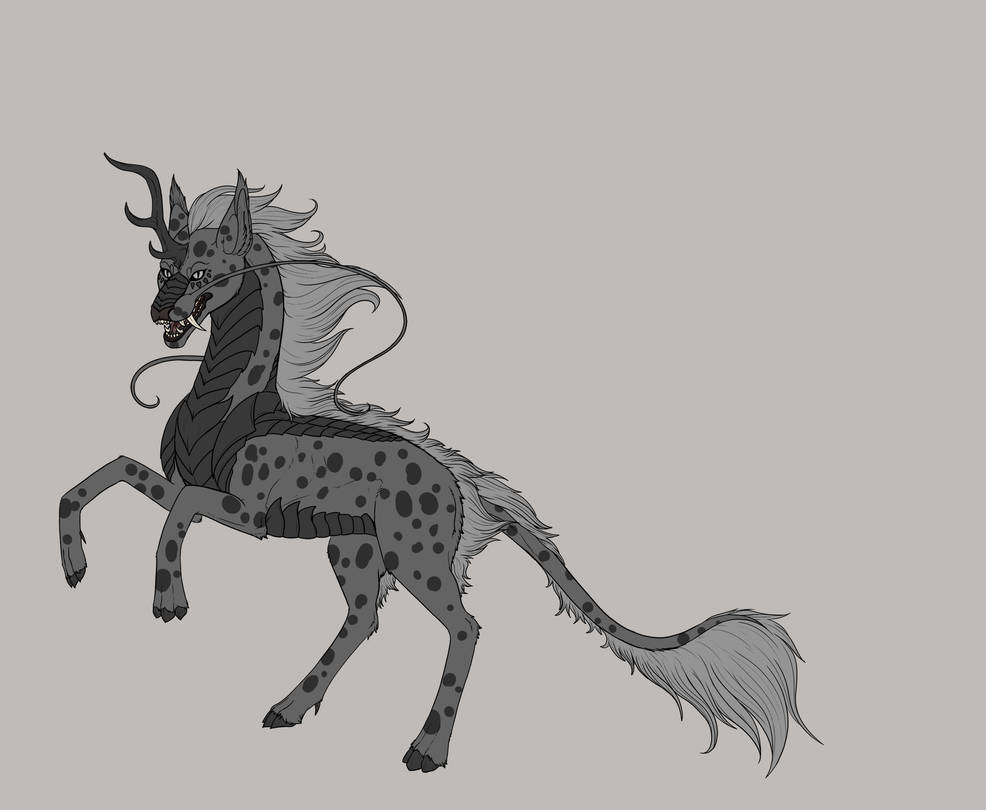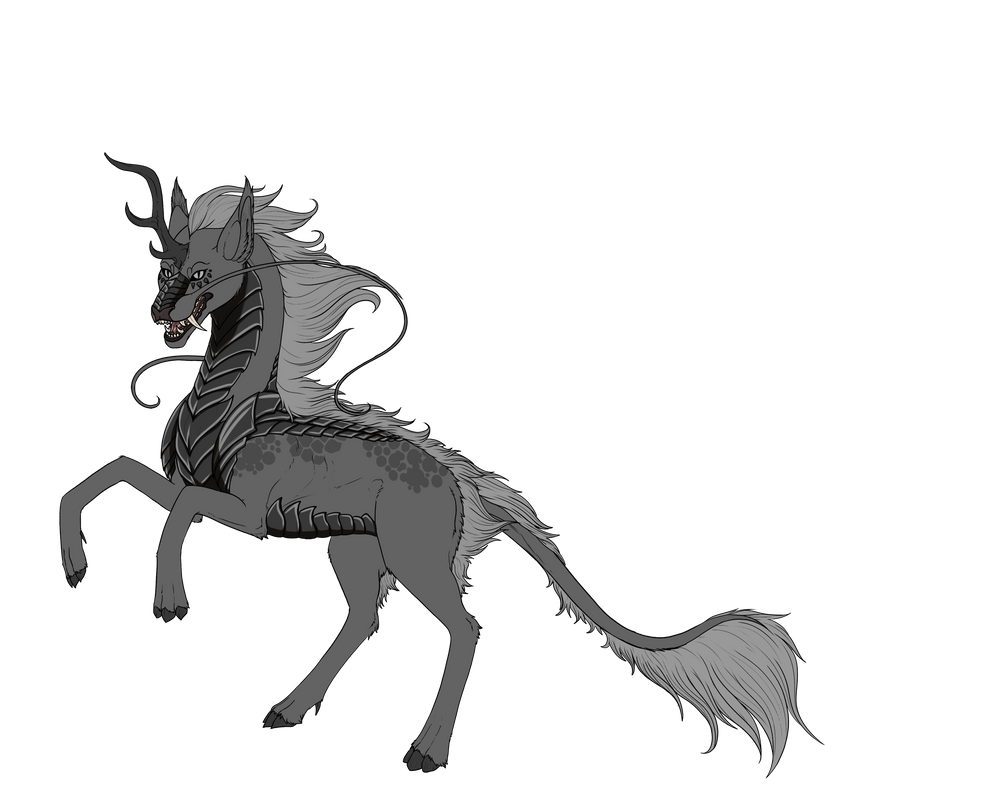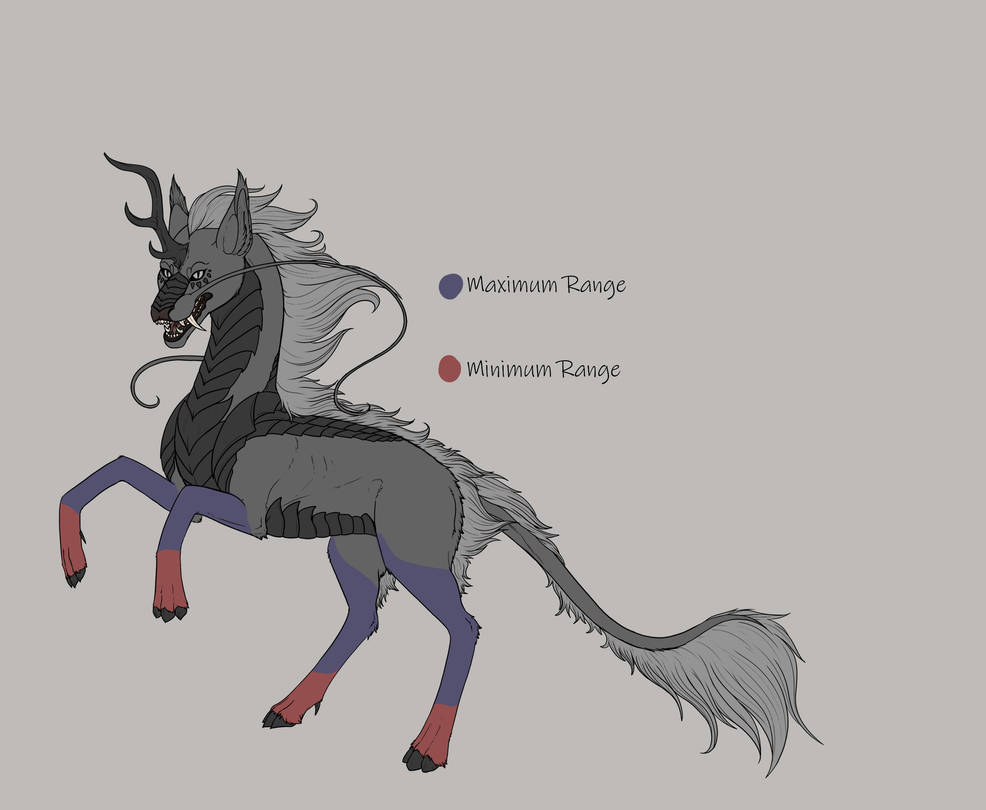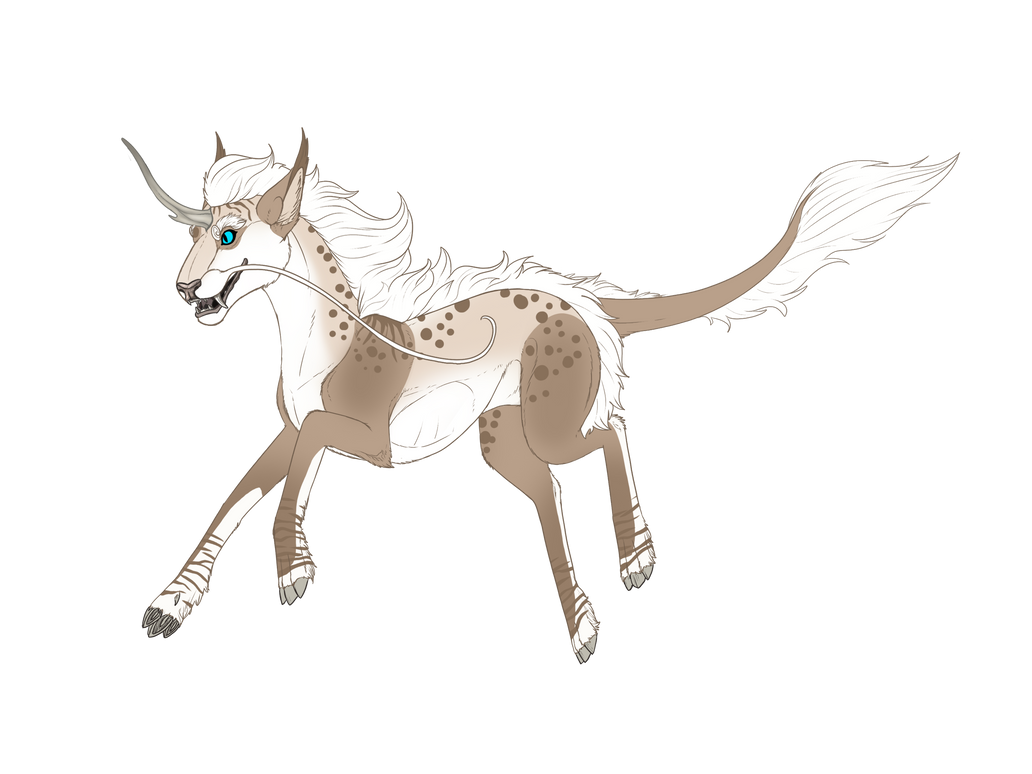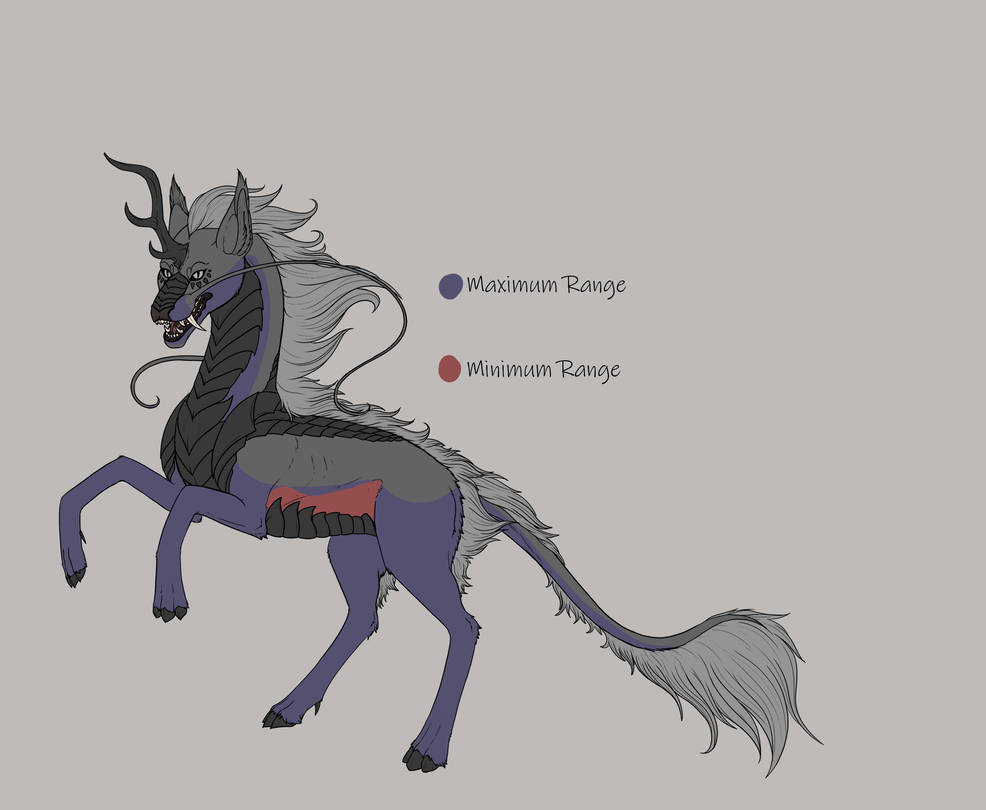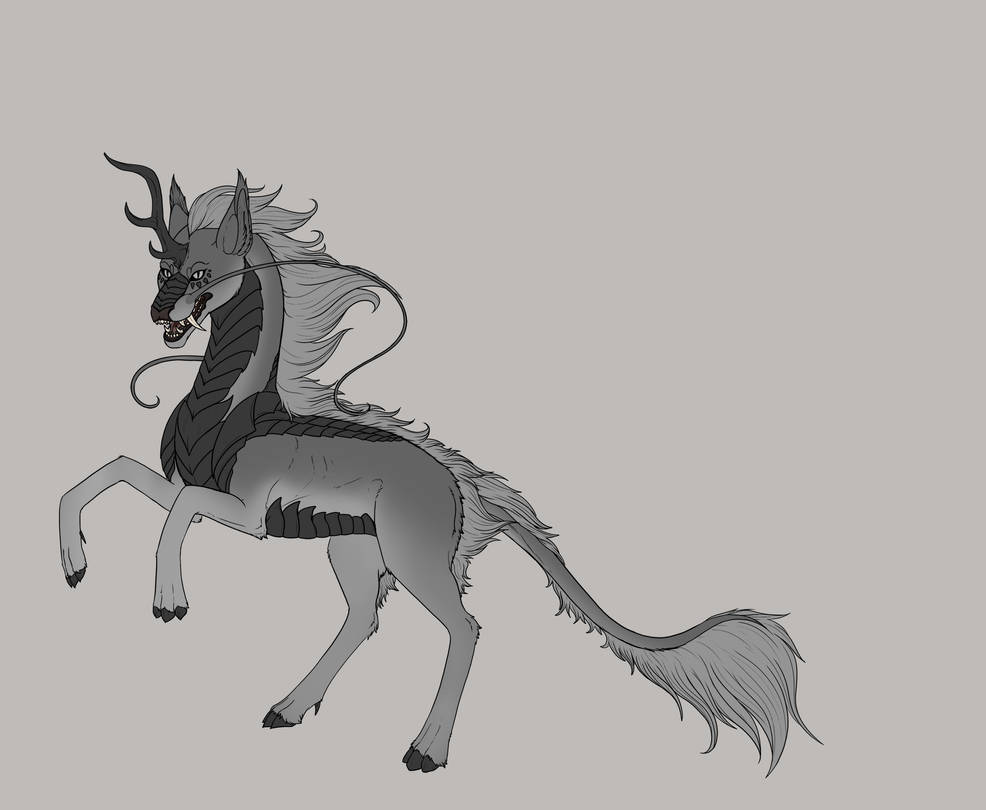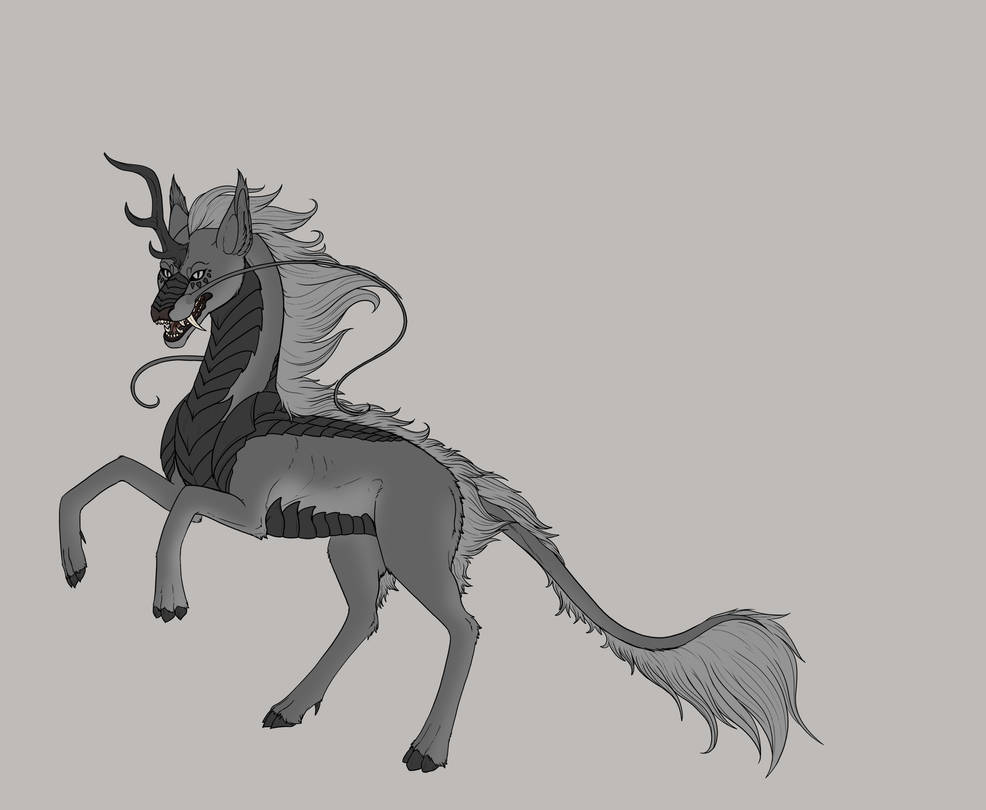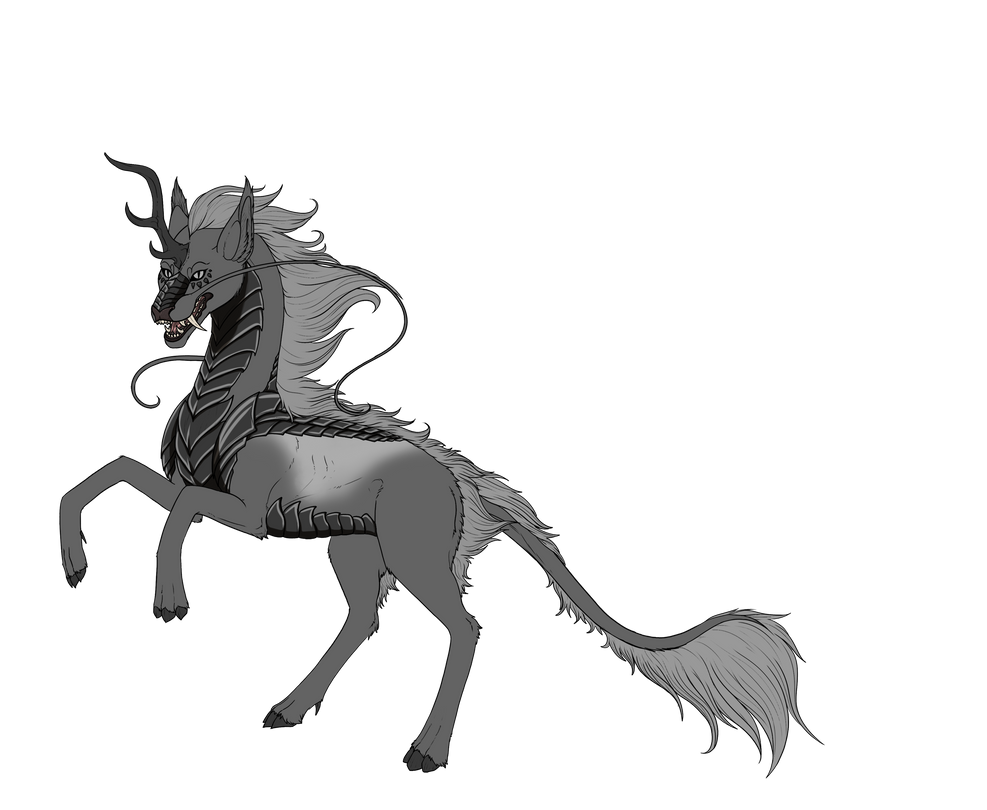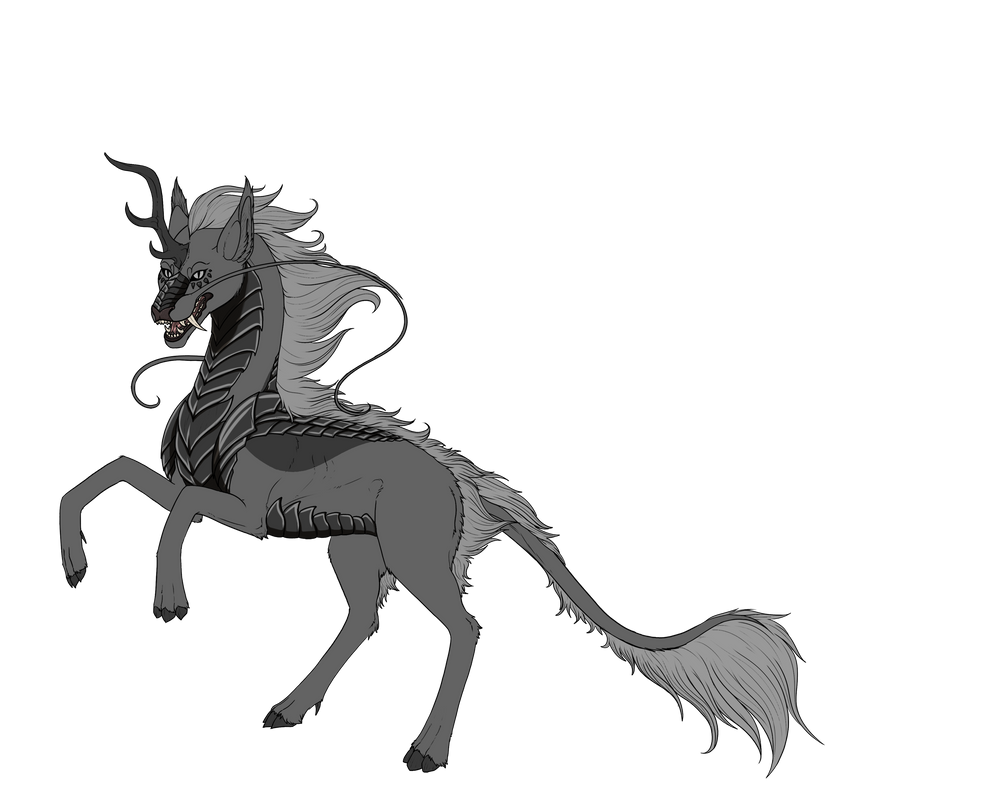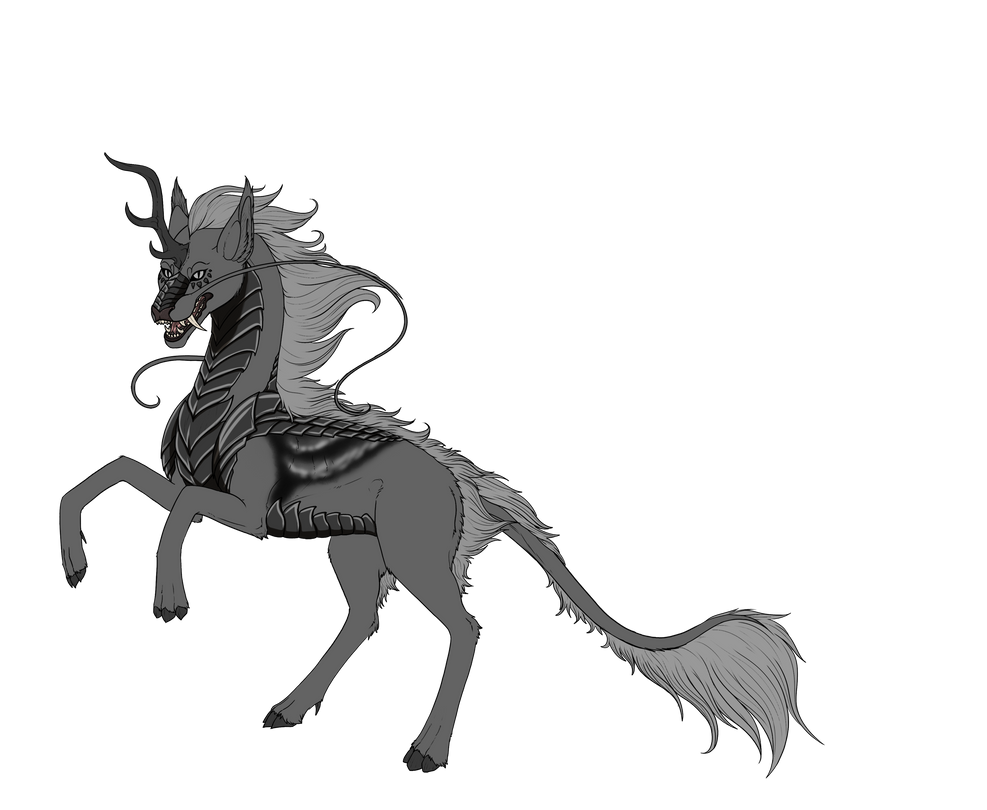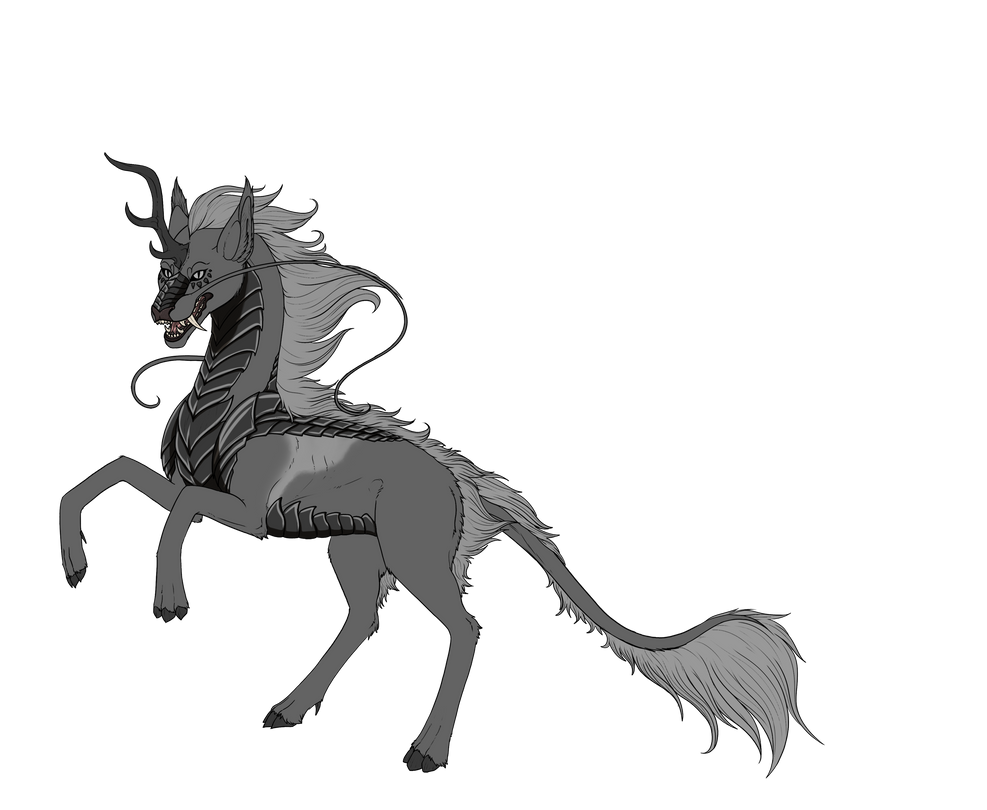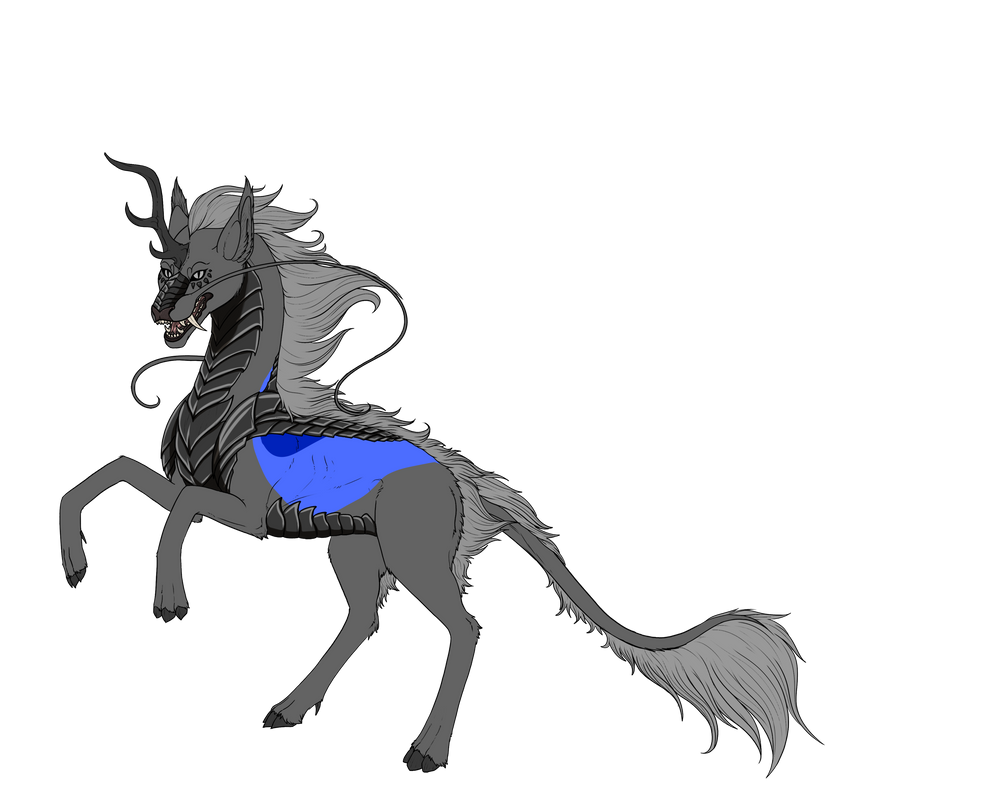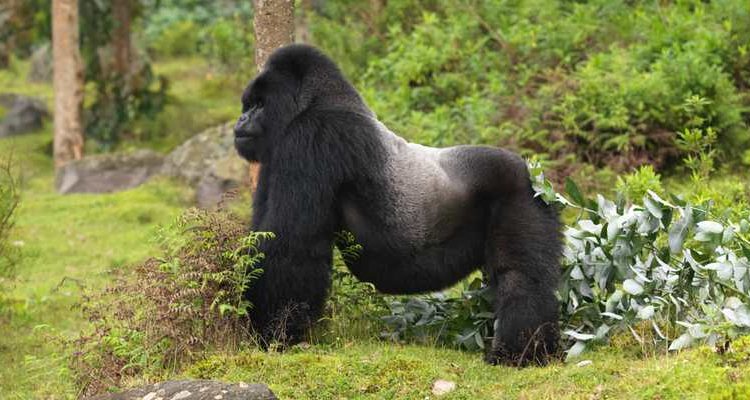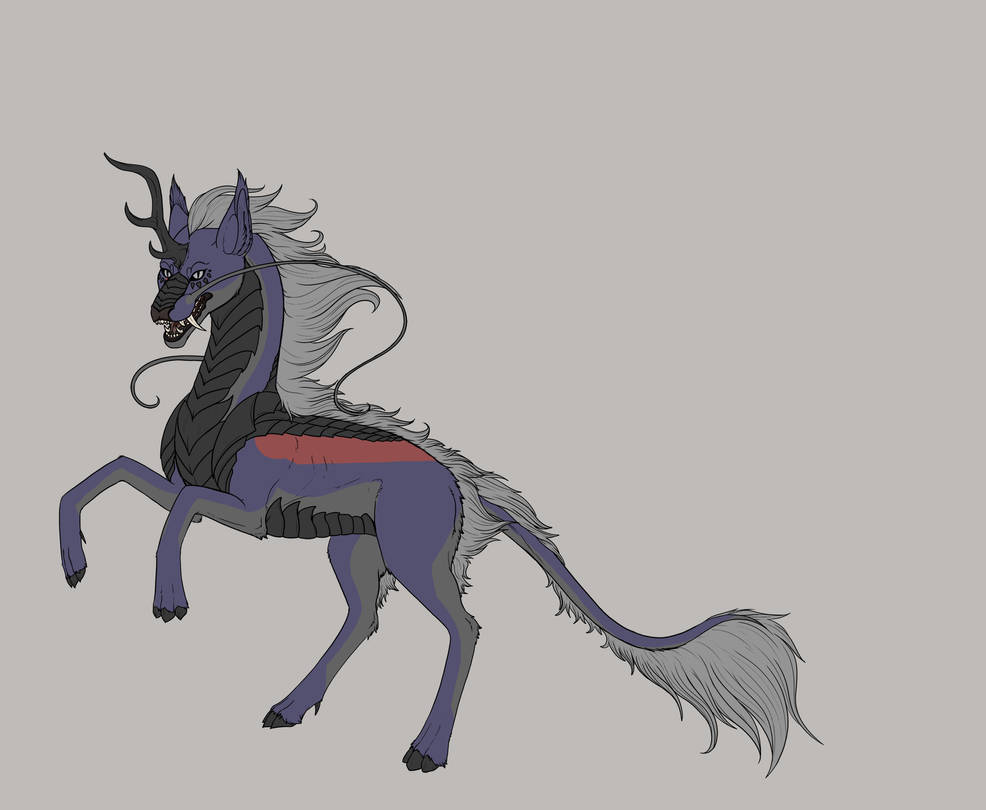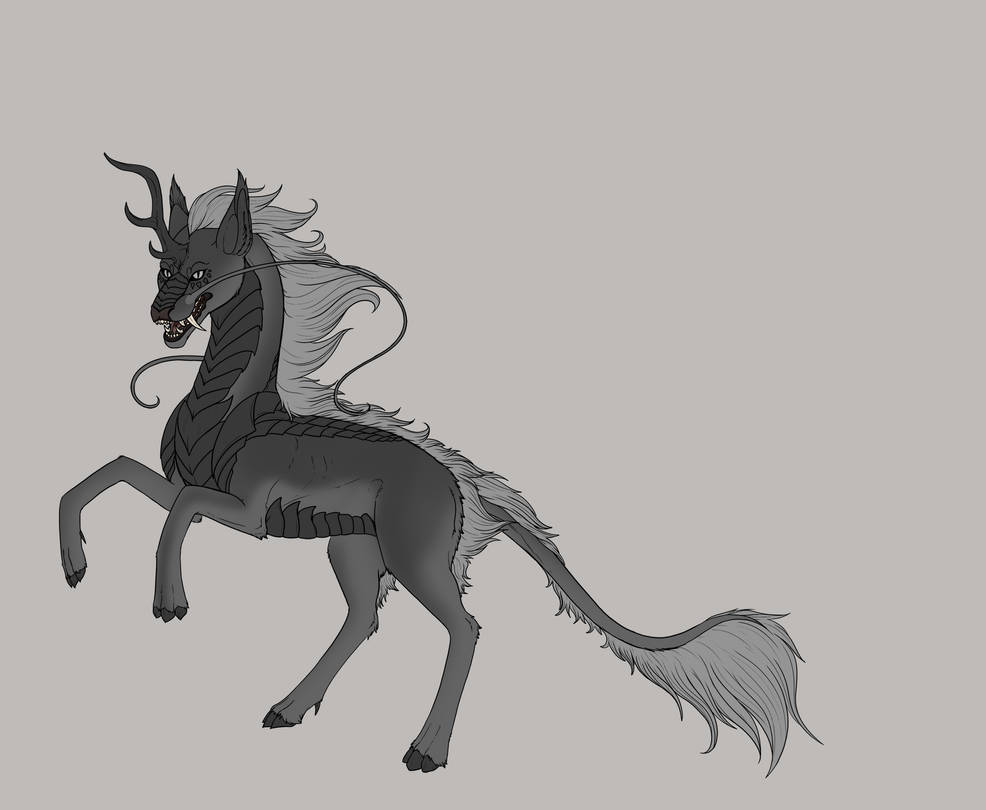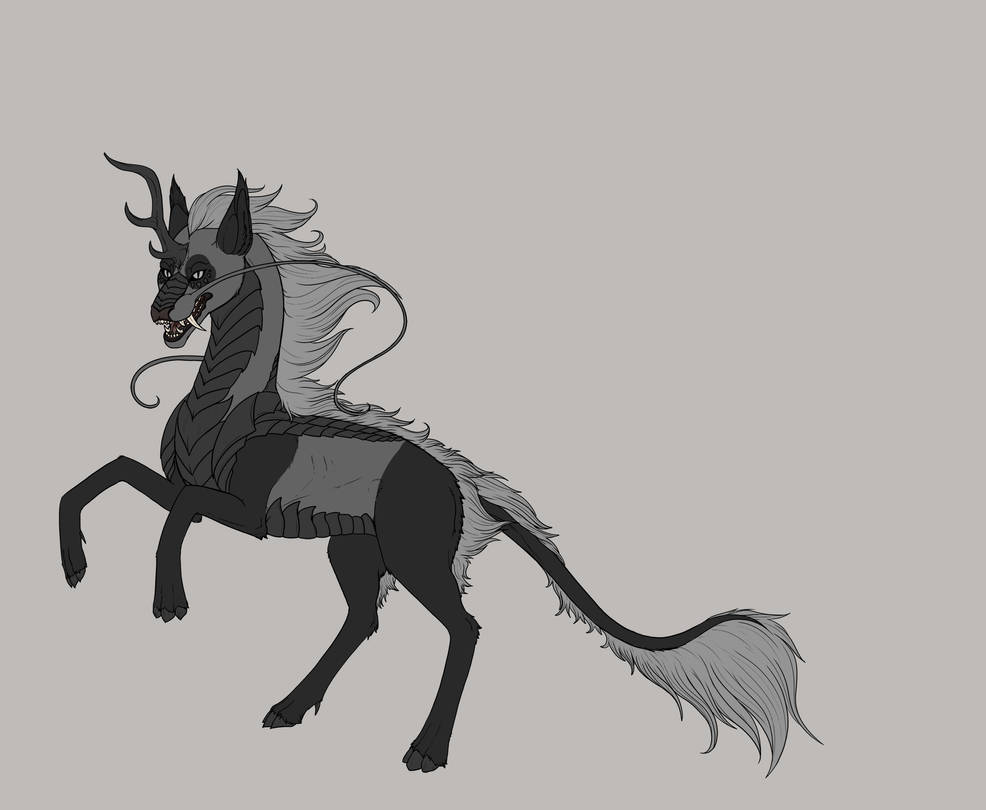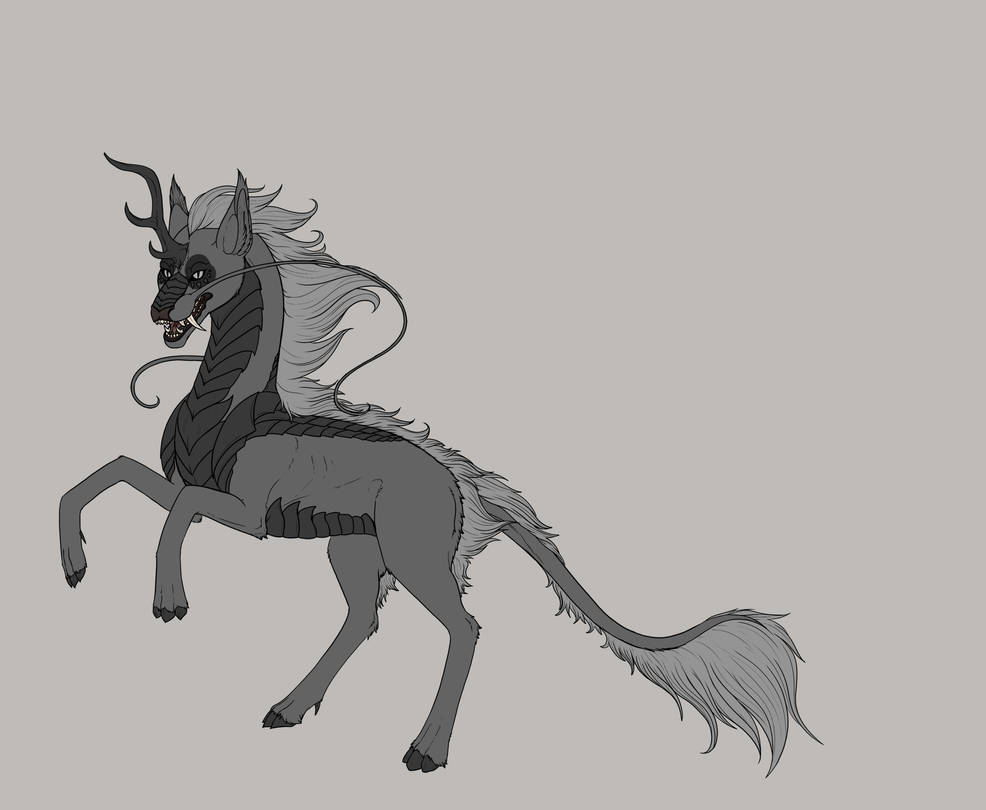Traits
Silver (Common)
Silver is a coat modifier that reduces the saturation of the Drakiri's coat. It doesn't lighten or darken the color, simply desaturates. Silver can be as subtle as a subtle lowering of saturation. If it's not obvious at a glance, mention that you did so in the comments when submitting your geno. Silver can also completely desaturate the Drakiri's coat, or leave hints of color.
Silver can use the palettes in the drive for the base, or you can design the Drakiri as normal and desaturate parts of them or all of them. Only the base coat must be desaturated, meaning all markings are allowed to still have their original saturation as long as it doesn't look too much like Glimmer. Glimmer can appear in full brighteness on Silver, though Silver can also negate the effects of Glimmer if you prefer this.
Note that the palettes in the drive are only a suggestion, and if you have another way you prefer to design your Drakiri, you may use your own method! If in doubt, just explain what you did in the comments, and if it's new and helpful, it will be added to the guides!
Optionally, Silver can give your Drakiri a Perlino effect. The Perlino effect allows the back, shoulders, and parts of the face of the Drakiri to be less saturated, leaving full saturation on the legs, belly, around the mouth, around the eyes, and on the underside of the tail. Of course this range is pretty loose, so have fun! Perlino effect should blend into the brush. Using a saturation layer mask and airbrushing the areas you want desaturated and playing with layer opacity is a very effective way to get this effect!
It is not required to effect the mane and the marking colors are also not required to be effected.
When interacting with Darken or Dilute, there are two options
1- Choose which one you'd like to use.
2 - Combine their effects in fun and creative ways.
Split (Common)
Split
OVERVIEW
- A common mane specific marking that creates wide bands of a natural color in the mane.
RANGE AND DETAILS
- This marking can effect all mane and tail fur
- Minimally, Split can make just the bangs of the Drakiri a different color than the rest, or one wide band anywhere in the mane. Up to 50% of the mane fur can be covered by this marking, and the wider bands can be mixed with the smaller bands.
- At least one band of color should appear on the mane, or up to three, with roughly half the mane being covered by this other color.
COLOR TEXTURE AND GRADIENT
- This marking can only be one color throughout and can not contain a gradient (Other than matching the allowable free mane gradient) unless effected by the marking Gradient.
LAYERING
- This marking can layer over or under other mane specific markings, but appears beneath piebald
OTHER INFORMATION
- Split can be effected by Vibrant Mane and Glimmer, but Split can also appear in natural colors on a mane that is effected by Vibrant Mane for some interesting effects.
GOOD EXAMPLES
Coming Soon
Flare (Common)
This marking is lighter than the base, and can be semisoft edged, or hard edged, or a combination. It effects the forelimbs, but can also effect other markings. It either creates markings that resemble stylized flames on the limbs, face and back, or modifies markings to have edges inspired by stylized flames in shape.
This must be fairly simple; it must not be able to be confused with Comet.
Flecks (Common)
OVERVIEW
- Flecked is a common marking found on the scales of a Drakiri. Flecked creates various uneven fleck like markings, similar to dalmation jasper or other stones. The example above shows several of the shapes Flecks can take.
RANGE AND DETAILS
- Flecks can appear on any scales on the body, and can also effect the hooves and horn/s. Flecked does not effect the body. On Drakiri with the Smooth mutation, Flecks can either appear on the horns and hooves, or not be visible on the import.
MIN RANGE
- Just a few little flecks somewhere on the scales, or on the hooves and/or horn/s.
MAX RANGE
- Every scale completely covered in the tricolored little markings
Color and Texture
- Flecks can be three shades of the scale color, with bits of white and bits of black in as well. Flecks should be a color relative to the scale color, or various shades of white, grey and black. When on the horns and hooves, Flecks can not reflect the color of the scales without Glimmer. It should then take natural colors, or the very dsaturated scale color if that is used on the horns. Flecks can be textured, and they can bunch together, but they should not be as big as the spots found in Stained or Bleached.
Possible Interactions
- When interacting with Stained or Bleached, it can create much larger splotches in with the flecks, and have flecking form a blend between the dark parts of the scales and the lighter parts. Interacting with Stained or Bleached adds a fourth shade of color to Flecks, interacting with both adds a fifth.
- When interacting with Iridescent scales, Flecks can take on a sparkly shine or metallic look, like bits of crystal or metal in stone.
Some Image inspiration
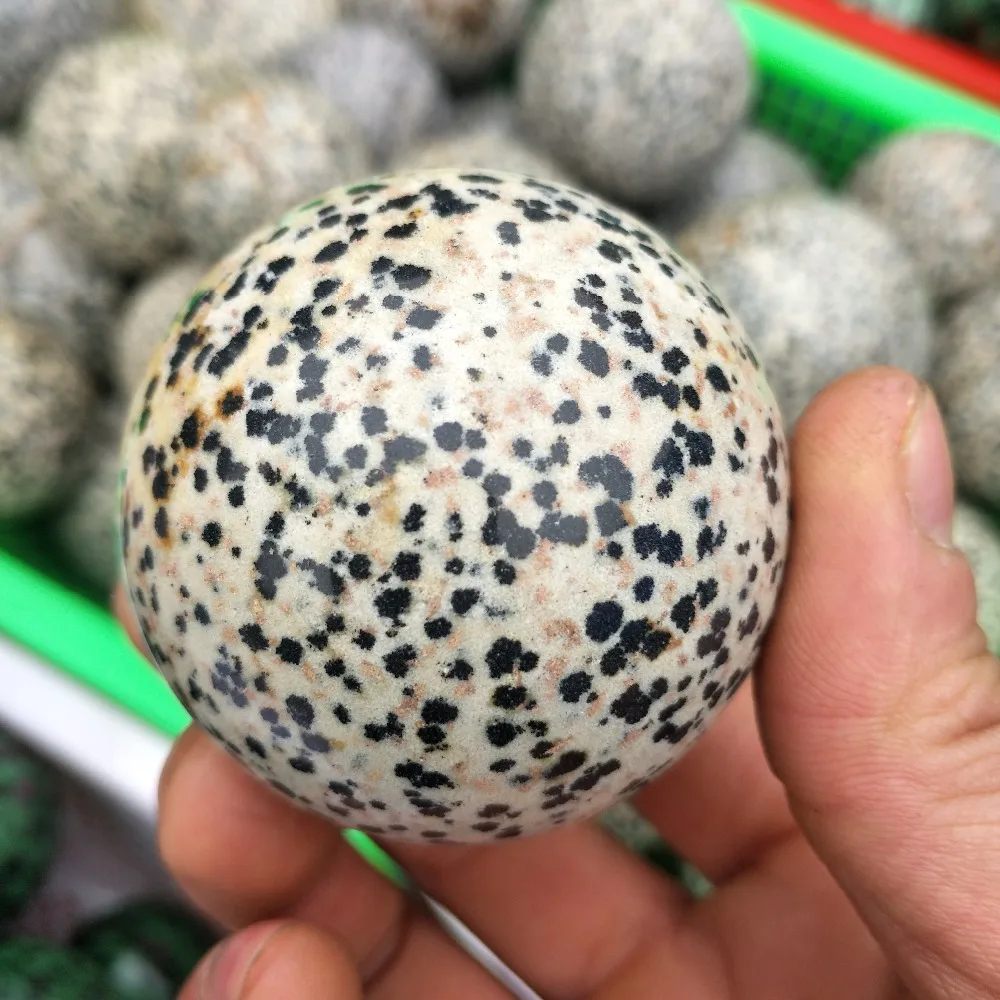

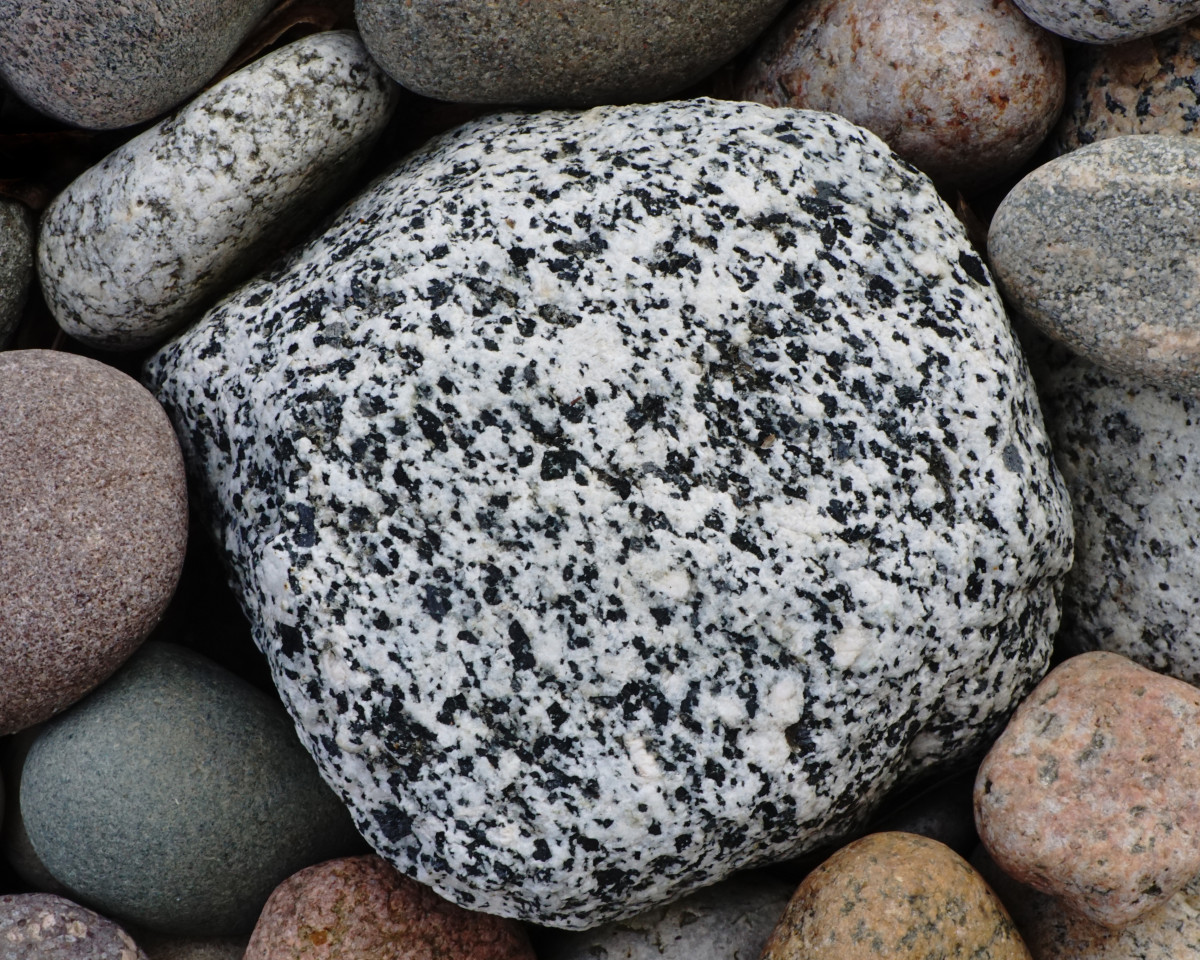
Ticked (Common)
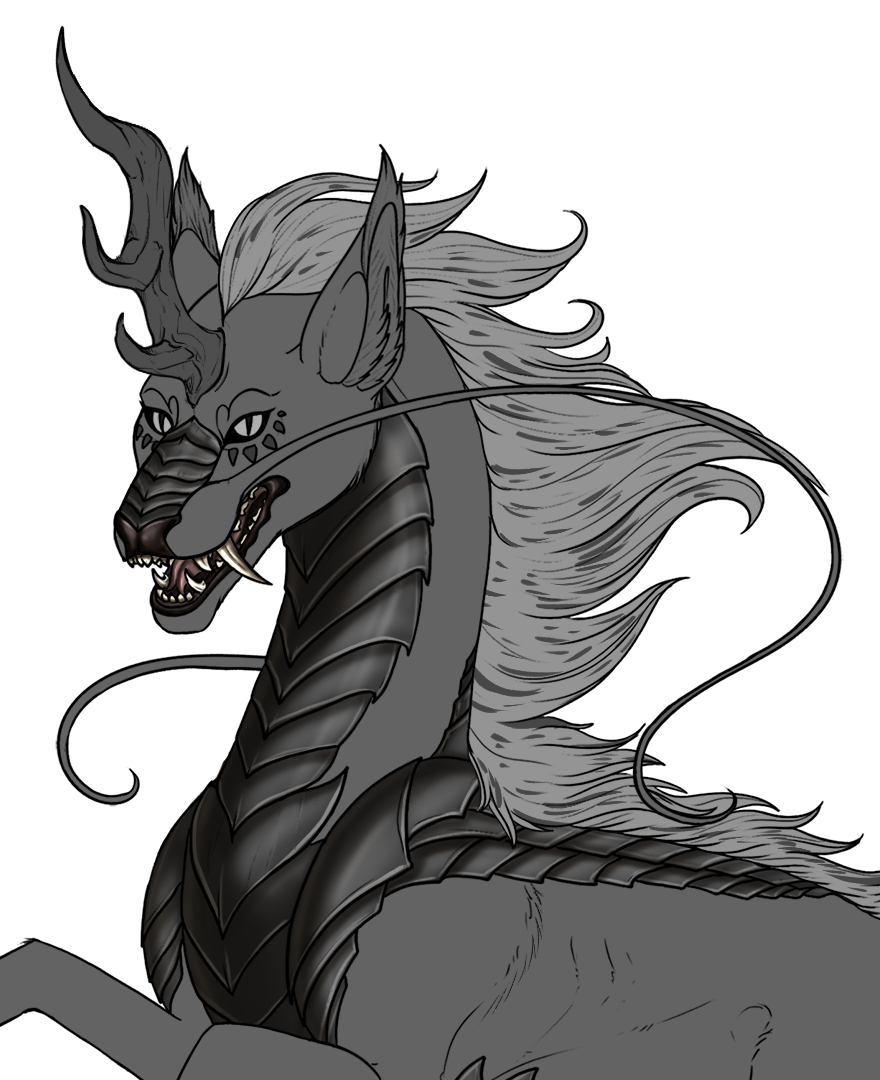
OVERVIEW
- Ticked is a mane specific marking that creates ticking and flecking in the mane and tail fur. Shown above are several examples of what Ticked can do. It can appear as fairly long, so long as it doesn't stretch from the body to the tip of the mane. Ticking can be lighter or darker than the mane beneath it, or a mix of light and dark. It can not too closely resemble Barring or Mane Tips, but it can interact with other mane markings for some really neat effects. How you make it interact is up to you!
RANGE AND DETAILS
- Ticked can only appear in the mane and tail fur. It can not appear on the body or anywhere else.
MIN RANGE
- Just a few tickmarks somewhere in the mane and tail fur
MAX RANGE
- Ticking all over the mane and tail fur.
Scale Stripes (Common)
OVERVIEW
- Stripes that appear on the scales
RANGE AND DETAILS
- Stripes of all sorts that appear on the scales, as extensive as dense banding all over them to a few stripes here and there. Horizontal or vertical stripes are allowed, but be careful not to make them resemble scale-restricted Strata.
MIN RANGE
- Just a couple stripes on the scales.
MAX RANGE
- Dense striping covering every scale on the Drakiri's body
COLOR TEXTURE AND GRADIENT
- Must be solid edged. Can not contain a gradient. Must be a lighter or darker shade of the scales, black, or white. Bicolor and Tricolor can make them a different color than the scales beneath.
LAYERING
- Layers over or under other scale specific markings.
PHYSICAL MUTATIONS
- Scale Stripes can only only affect scale mutations.
GOOD EXAMPLES
Coming Soon!
Striped (Common)
STRIPED
OVERVIEW
- Simple striping appearing on the body of the Drakiri similar to the shape of a Thylacine's stripes. Simple, but over the whole back and head.
RANGE AND DETAILS
- Striped has many ways that it can appear on the Drakiri.
MIN RANGE
- Must minimally appear in the red ranges as small stripes.
MAX RANGE
- Must not extend out of the blue range on the Drakiri.
OTHER RANGE INFO
- Striped may effect the mane, but not in full stripes, but rather blending into the mane where it touches the mane.
- Stiped does not affect the scales even with Marked Scales present
- Striped does not affect the limbs of the Drakiri
- Striped may have up to 3 connected but simple V shapes. It also doesn't have to connect with the back. It may not fork, however.
- It may have a subtle sway.
- It can either be thin, or thick, but can not wrap around the Drakiri.
COLOR TEXTURE AND GRADIENT
- Striped can be any natural color lighter or darker than the base coat that does not clash with the base coat.
- Striped must have a solid or subtle fur textured edges.
- Striped can only be one color.
LAYERING
- Striped can layer over or under any other marking aside from Stone and Piebald.
PHYSICAL MUTATIONS
- Striped can effect the wings on Drakiri with Phoenix, as well as forming banding like the banding on a falcon's wings as well as covering the tips.
- Striped can not effect the scales, even with Marked Scales present
GOOD EXAMPLES
Coming Soon!
Stained (Common)
STAINED
OVERVIEW
- Stained is a marking that either adds dark spots, patches or splotches to the scales, or darkens scales on part of the Drakiri, specifically the scales on the back and shoulders, or the muzzle. This marking can be black, or a darker shade of the scale color used.
RANGE AND DETAILS
- Stained can effect all scales on the Drakiri.
MIN RANGE
- Must appear in at least a few spots or patches here and there on the Drakiri's scales. Can also alternate in darkening every other scale.
MAX RANGE
- Can cover all of the scales in spots.
COLOR TEXTURE AND GRADIENT
- Stained can only be one shade throughout the marking unless effected by Gradient.
- Stained however is allowed to fade into the scale color.
- Stained can be effected by Glimmer, Bicolor, Tricolor and Spectrum, but can not be effected by Reversal.
LAYERING
- Stained must appear below Piebald and Stone
PHYSICAL MUTATIONS
- All scales from Extended or Reduced Scales can be affected by Stained.
OTHER INFORMATION
- Stained can not be effected by reversal
- Stained and Bleached can interact to create three different shades of the scale color on a Drakiri or create interesting effects with Bicolor or Tricolor.
GOOD EXAMPLES
Coming Soon
Spots (Common)
Spots
OVERVIEW
- Dark spots appearing on the coat of the Drakiri similar to a dalmation
- Round or shaped spots/splotches in varying sizes. It can also form clusters of round spots resembling bubbles. Spots can attach to markings to modify their edges with small "bubbles". Must be darker than the base coat.
RANGE AND DETAILS
- Spots can appear anywhere on the Drakiri's coat
- Spots can be pretty small, but they shouldn't be so small that they can be confused with Fleabitten
Min Range
- At least a few spots here and there should show on the Drakiri's coat.
Max Range
- Spots can appear all over a Drakiri's coat
Other Range Info
- Spots can extend onto the horns and hooves
- Spots can not affect the mane
- Spots can not affect the scales even with Marked Scales present.
COLOR TEXTURE AND GRADIENT
- Spots can be elongated, fur textured, oval, or round.
- Spots can have subtly soft edges, like the dapples on a horse, but dark.
- Spots may not contain a gradient and must be one color throughout.
- Spots can be any natural color darker than the base coat.
LAYERING
- Spots can layer over or under any marking aside from markings such as Piebald, Stone, and Satin. Spots, however, is unique in that it can layer over Roan, unlike other markings.
PHYSICAL MUTATIONS
- Spots can appear on the wings.
OTHER INFORMATION
- Spots can not be affected by Reversal
- Spots can not be affected by Marked Scales
GOOD EXAMPLES
Socks (Common)
SOCKS
OVERVIEW
- A solid marking that appears on the limbs of the Drakiri. It can either cover the limb, or appear along the limb. You can see an example above.
RANGE AND DETAILS
- Socks can either cover the entire leg of the Drakiri, or just the area near the hoof. They can also just appear on part of the leg, resembling the markings found on a black and tan dog. If Socks and Siamese are on the same geno, Siamese may completely cover up socks, or they can interact to have a softer edged Sock.
MIN RANGE
- Shown in red, Socks must appear on at least one limb.
MAX RANGE
- Socks can cover the entire limb on the Drakiri.
OTHER RANGE INFO
- Socks does not have to cover all four of the Drakiri's limbs.
- Socks can effect the mane wherever it touches
- Socks does not affect the scales
COLOR TEXTURE AND GRADIENT
- Socks must be hard edged, or with a subtle fur texture.
- Socks can be any natural color lighter or darker than the base coat.
- Socks can contain a very subtle gradient within the marking originating at the hoof.
- Socks can not contain holes unless Cutout is present
LAYERING
- Socks can appear above or below any markings except the following
- Piebald, Stone, Frosted and Fleabitten. It must appear beneath these markings.
PHYSICAL MUTATIONS
- Socks can color the flight feathers on Phoenix, or the ends of the wings for those with membranes.
GOOD EXAMPLES
Coming Soon!
Pangare (Common)
OVERVIEW
A soft light colored gradient marking appearing on the underside of the Drakiri.
RANGE AND DETAILS
- Pangare can only effect the underside of the Drakiri
MIN RANGE
- Minimally, it must appear on the belly area.
MAX RANGE
- It can cover the entire underside of the Drakiri.
OTHER RANGE INFO
- Pangare does not have to cover the entire leg. It can cover just the back of the leg. If covering the entire leg, Pangare must extend onto the belly as well to avoid looking like reversed Siamese.
- Pangare can not effect the mane or tail fur
- Pangare does not effect the scales, even with Marked Scales present
- Pangare can cover up Underbelly if both are present on a geno, or, alternatively, be covered up by Underbelly. Only one has to show on your import of the geno has both.
COLOR TEXTURE AND GRADIENT
- Pangare can be any natural color that is lighter than the base coat.
- Pangare is a soft marking. The edges can not be distinct, they must blend into the color beneath unless interacting with Underbelly. Then it can create a semi-hard edge. Pangare can optionally cover up Underbelly, or be covered up by Underbelly if both are present on a geno.
- Pangare may not have holes.
- Pangare must be one shade throughout unless effected by Gradient
LAYERING
- Pangare can layer above or below any other marking. It must, however, appear beneath Stone and Piebald.
PHYSICAL MUTATIONS
- Pangare can effect the following mutations
- Phoenix - the flight feathers or membranes only, and only the underside
GOOD EXAMPLES
Coming Soon!
Saddle (Common)
OVERVIEW
- Saddle creates a patch of color on the back. It can have a subtle fur texture, be hard edged, have soft edge or be a gradient. It most often resembles the marking on the back of a Silverback gorilla or a blackbacked jackal. The texturing within, fading into the coat gives it a nice effect, and it can double up with Blanket for further neat effects.
RANGE AND DETAILS
- Saddle is fairly versatile with a couple different expressions.
MIN RANGE
- A tiny patch just behind the neck.
MAX RANGE
- It only effects the back, can not extend onto the limbs. It should not extend outside of the max range shown above.
COLOR TEXTURE AND GRADIENT
- It can not contain a gradient unless Gradient is present, though the edges can be subtly textured, solid, soft, or semisoft.
- Saddle can be any natural color lighter or darker than the base coat. It can also desaturate the coat where it is effecting when lightening it.
- Saddle can have mixes of its light and dark expression, allowing it to resemble a black-backed jackal.
LAYERING
- This is a base coat affecting mark. Blanket or Sable may hide this marking if they appear on the same geno, or they can interact, or Saddle can appear over top of Blanket or Sable.
PHYSICAL MUTATIONS
- Saddle can effect the arm area of the wing for Phoenix.
GOOD EXAMPLES
Coming Soon!
Sable (Common)
SABLE
OVERVIEW
- Sable is a soft dark marking on the topside of the Drakiri. If Sable and Blanket are present on the same geno, you may choose which one shows if you don't want to have them appear together or interact.
RANGE AND DETAILS
- Sable can darken the top half of the Drakiri, but it does have some limits.
MIN RANGE
- Sable must at least appear on the back of the Drakiri, as seen on the above image.
MAX RANGE
- Sable may appear anywhere within the blue range on the above image.
OTHER RANGE INFO
- Darkening on the legs must be subtle.
- Sable does not effect the mane
- Sable does not affect the scales, even with Marked Scales present
- May not be broken up or have holes in it without the presence of Cutout.
COLOR TEXTURE AND GRADIENT
- Sable is a soft gradient marking so no hard edge will be allowed.
- Sable must be darker than the base coat, but can be any natural color that is darker than the base coat, including deep reddish brown on a black base coat as long as it is not noticeably lighter.
- Sable may contain up to two shades of one color, with the darkest areas closest to the back and shoulders. Gradient can add a third.
- Sable's minimum must be more expansive than Saddle's range - this means that Sable must, at its absolute minimum, either cover the entire back of the neck, entire back, or at least part of the legs as well as the shoulders. Sable is not allowed to restrict to only the shoulder area, to avoid confusion with a dark Saddle.
LAYERING
- Sable is considered a base coat marking, and layers beneath most other markings
PHYSICAL MUTATIONS
- Sable can effect the following mutations
- Phoenix - cover the arm part of wing
GOOD EXAMPLES
Coming Soon
Panda (Common)
PANDA
OVERVIEW
- A dark marking resembling the markings on a panda.
RANGE AND DETAILS
- Panda can cover the limbs, tail, ears, and patches around the eyes.
MIN RANGE
- Panda must at least show as patches on the eye.
MAX RANGE
- The marking can cover the entire front and rear limbs, along with the tail and ears of the Drakiri.
OTHER RANGE INFO
- Panda can cover just the front legs if desired, but must cover the entire leg up to the withers. It can also only cover the rear leg, and does not have to cover the tail.
- Panda does not affect the scales
- Panda can affect the mane or tail fur
COLOR TEXTURE AND GRADIENT
- Panda can be any natural color darker than the base coat.
- Panda can not have holes
- Panda must have hard edges, or slightly fur textured.
- Panda must be one shade throughout, it can not contain a gradient.
LAYERING
- Panda can layer over or under any marking. It must appear beneath Frosted, Fleabitten, Piebald or Stone.
PHYSICAL MUTATIONS
- Panda can color the wings of Phoenix as long as it's also covering at least the forelimbs.
GOOD EXAMPLES
Coming Soon

